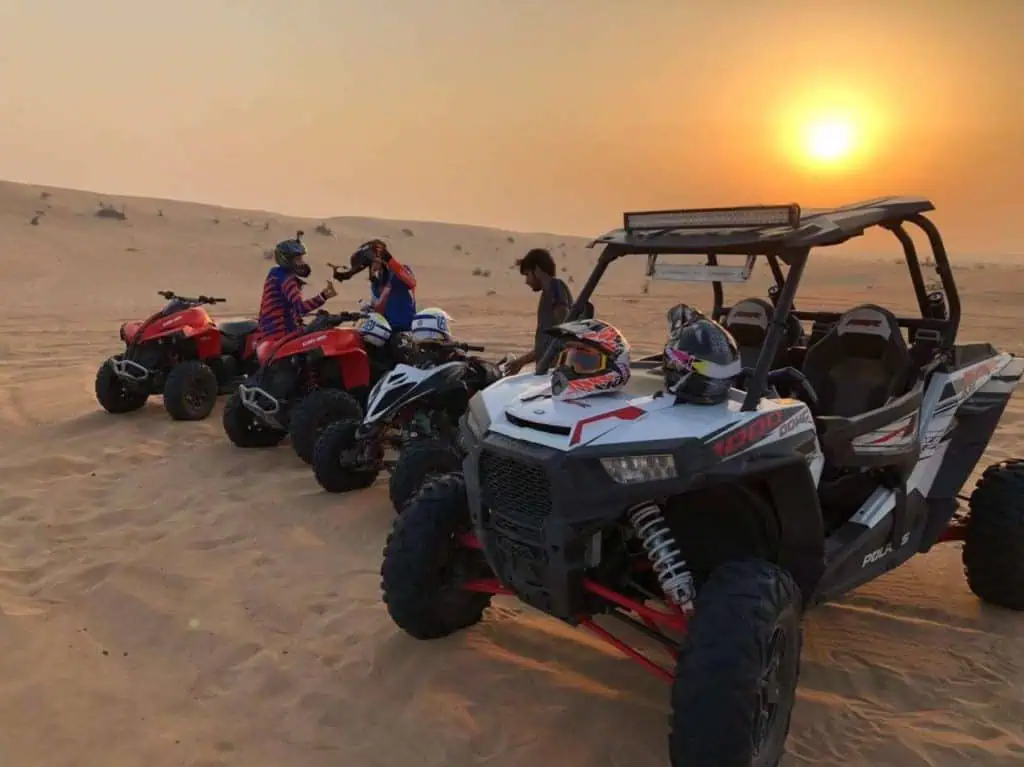Before you start! Before you commit to learning anything at all about riding an ATV, take the time to go through your manual.
You’ll also want to set aside a nice practice area you can use while you familiarize yourself with your new ride; you don’t want to combine the unique challenges of riding your ATV with additional challenges from an unfamiliar environment.
Basic Riding
Good posture makes for a good rider—learn to ride with poor posture, and you’ll find advanced techniques and more difficult terrain increasingly difficult to cope with.
- Eyes forward, watching the ground well ahead of you.
- Shoulders relaxed, arms held out slightly so your elbows can’t jar your body.
- Knees tucked in towards the body, feet on the footrests with toes ahead.
An ATV demands active engagement. You’re often going to feel more like you’re crouching or standing, even if your butt stays in the seat.
For starting, a forward, well-tucked-in posture will serve you best. You want to be a bit tense so your body weight doesn’t fall behind when you first touch the throttle. Start slow and gentle and work your way up to more rapid acceleration and higher top speeds.
To stop, you want to use your front and rear brakes together. Again, you want to sink in and focus on keeping your weight centered—otherwise, your body will be inclined to go forward over the handlebars.
For turns, you’ll need to lean forward and towards the inside of the turn. Lean harder the sharper the turn. If you start to lose the ATV to a tip-over, lean harder into the turn, slow down and try to widen the turn if you have room to do so.
Riding on hills
Once you’re ready to graduate from riding on flat land, your next step should be the master riding up hills.
Most of the logic stays the same whether you’re going up hills or down them, though it can feel quite different as a rider. You want to keep your weight uphill as much as possible. Use both brakes together or the uphill brake alone, never the downhill brake alone.
If you lose momentum going up a hill, don’t try to reverse back down; turn and ride back down, or stop, engage the parking brake, and dismount.
Trail Riding
Whether you’re riding your ATV for the thrill of riding or using it as transportation in areas where a car isn’t viable, you’re going to want to learn the basic skills involved in trail riding.
- Know the terrain. You should avoid riding on unfamiliar land; a surprise drop or marsh can lead to a serious disaster.
- Scan ahead. Terrain changes, even on familiar trails. Watch ahead so you can identify clean routes and avoid nasty surprises.
- Relax. If you’re extremely tense and hyper-focused on every obstacle, you’re going to end up missing something important. If you can’t keep up without getting nervous, slow down. Speed will come with time.
Obstacles
Whether you’re seeking them out intentionally for a challenge or encountering them unexpectedly on your favorite trail, learning to navigate obstacles is a key skill for any ATV rider. Tackling any obstacle will come down to a few simple steps, though the execution can be quite complex:
- Raise yourself off your seat, keeping a firm but springy posture with bent knees.
- Hold the handlebars firmly, and make sure you’re heading perfectly straight.
- Give just a little extra gas as your front wheels hit the obstacle to get them over.
- Let off the gas and lean forward to remove weight from the bar wheels.
Don’t let your back wheels hit while you’re still giving throttle, or you may lose control of your ATV.
Reversing
An ATV isn’t particularly graceful when reversing, so make sure you practice and get familiar with reverse in a safe, simple environment. That way, if you ever need to reverse safely and effectively, you’re not fumbling with your ATV.
To steer in reverse, just keep in mind the curve you’re making by turning. If you steer the front right, you’re making a ‘C’ shape. That means you’re going to head towards the right whether you’re going forwards or backward.
Because ATVs aren’t good at reversing, most offer limited power when reversing by default. Your ATV may have an override button to allow you to get out of tricky situations, but only use it for specific problems—reversing at full speed on an ATV is a good way to end up seriously hurt.
